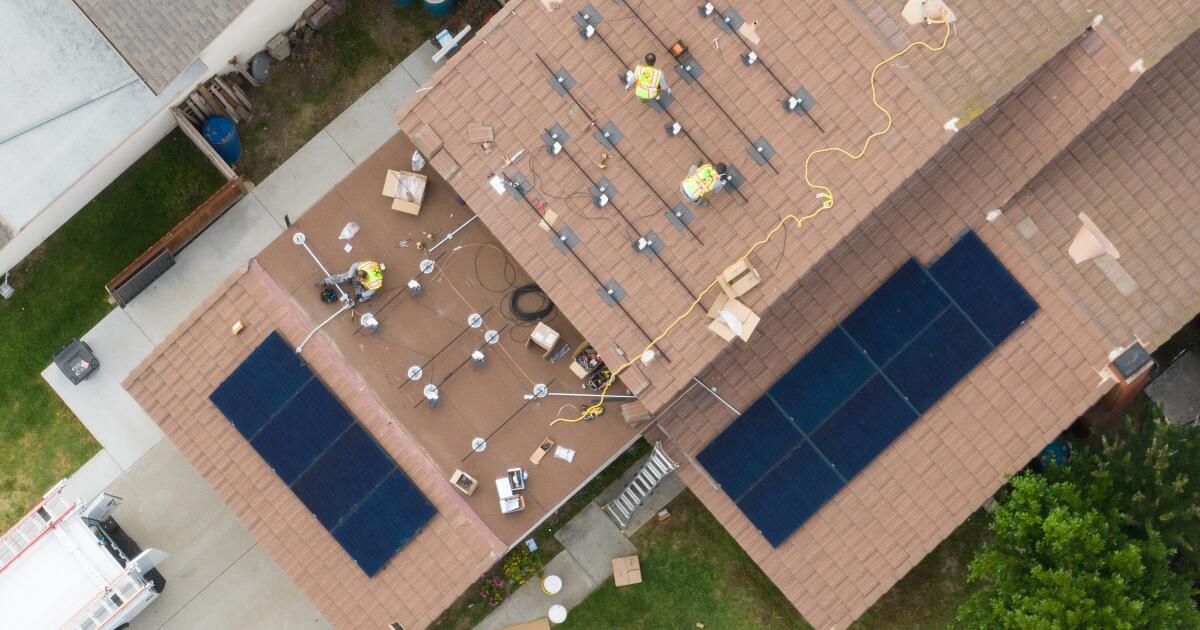- cross-posted to:
- climate@slrpnk.net
But critics insist the costs of those solar panels are beginning to outweigh the benefits.
Incentive payments to homes with solar, they say, have led to higher electricity rates for everyone else — including families that can’t afford rooftop panels. If so, that’s not only unfair, it’s damaging to the state’s climate progress. Higher electricity rates make it less likely that people will drive electric cars and install electric heat pumps in their homes — crucial climate solutions.
The solar industry disputes the argument that solar incentive payments are driving up rates, as do many environmental activists. But Newsom’s appointees to the Public Utilities Commission are convinced, as they made clear Thursday.
“We need to reach our [climate] goals as fast as we can,” said Alice Reynolds, the commission’s president. “But we also need to be extremely thoughtful about how we reach our climate change goals in the most cost-effective manner.”
When I am having a stroke, I don’t stop and calculate of the most cost effective treatment options. I go to the emergency room. We could have done this calculation in 1970 and acted, but that ship has sailed.

Sure seems to me that the California Utilities Commission is serving the big utility corporations at the expense of people wanting rooftop solar, and at the expense of our renewable energy future. Solar is cutting into their profits.

Every dollar the state spends on subsidizing private individuals’ renewable energy projects is a dollar the state can’t spend on public, at-scale renewal energy projects.
I don’t understand. What’s the difference? One one hand, energy production is distributed and on the other it’s centralized.
What I mean is, if eveyone had solar then we would have a “public, at-scale renewable energy project”

Decentralized power generation can be good for redundancy/resilency/off-the-grid purposes, but if you want the highest efficiency, you need large scale, centrally engineered not-for-profit projects.

You only need high efficiency if your energy source costs money.
When your energy source falls out of the sky every damn day, efficiency is irrelevant.

Yes as we all know it is free to build solar panels. It is free to write the software to control the solar panel. It is free to wire the solar panels to the grid and solar panels and all supporting hardware last forever.
And since all of this is 100% free, there is also absolutely no difference in the energy collected or the amount of materials used between 10,000 contractors slapping down some solar panels in dubious configurations as quickly as possible so they can get their subsidized installation fees, versus a centralized public project designed to minimize transmission losses, material waste, and maximize longevity and light energy collection.

Yes, yes, those are all very good points.
Another very good point is “taxes”.
A centralized project necessarily involves regular (monthly) transactions between a seller and a buyer. That involves metering expenses. Accounting. Billing. Collections when some of your customers don’t pay their bills. Losses, when collections don’t work. A legal department. The liability associated with having deep pockets in a litigious society. Inflation: your costs are going to be rising on a regular basis to keep up with it. Managers and supervisors. An HR department. A CEO, board of directors. Shareholders.
And, of course, every kWh you sell is taxed by the government, every bill, every month. That just isn’t true of a personally-owned solar panel.
You have a wide variety of continuing operational expenses associated with all those transactions you have to conduct between your centralized project and the customer. Those made sense with fossil fuel generation: a small, household generator has a high fuel bill. A central facility can buy fuel cheaper, and their larger engines are more economical. That margin leaves a lot of room to fund the additional overhead needed to sell power to the consumer.
But, if he has free fuel available (virtually nil operating costs) at home, all those efficiency gains are irrelevant: he can still be cheaper while being less efficient.
Save the centralized projects for things that rooftop solar can’t do: distribution, storage, etc.
the cost argument is silly

In theory you’re not wrong. The problems with this in practice are several, which I won’t go into, except to say that it’s a very American/individualistic/neoliberal solution to what is a collective problem.

I’ll add that I’m not universally against installing small projects. It has its uses. Given federal dollars I think it’s fine to have such projects in the mix, just not as the bulk of the infrastructure.

I think they should move to subsidising home batteries instead, just to smooth out the peaks and troughs that come with renewables. If you do that, and add some smarts to electric car chargers you’d be able to remove the need for fossil powered peaker plants. Solar is generating more than can be used on some days, and we need to focus on time shifting load and generation when possible.

If roof top solar is so essential then just make it mandatory. Stop fiddling with market incentives or, better yet, built more state run nuclear.

Incentive payments to homes with solar, they say, have led to higher electricity rates for everyone else — including families that can’t afford rooftop panels.
If they can’t afford rooftop panels, but can afford traditional generation, the rates aren’t yet high enough.

They can’t afford any of it. Two points.
Point A) Renters. They’re renting. The new change will…
… make solar panels less economically enticing for apartment dwellers, farmers, schools and strip malls, solar companies say.
– there were harsher proposals, but this is a mid-way kinda where renters will get something but not as much as others.
renters will be paid much less than they are today for electricity generated by their rooftop panels above and beyond what they and their neighbors use — electricity that is sent to the larger power grid, helping the rest of us keep the lights on.
Point B) They’ve made it pointless for schools and farms:
other utility customers affected by the decision — including schools and farms — will still have to pay full retail rates for all the electricity they consume. Even if they install solar panels that cover some of their consumption, they’ll have to pay their utility for power during times of day when their panels are generating.
Under the new rules, “schools will not be permitted to generate their own power any longer. Instead, they’ll be forced to buy their own solar back from utilities at full price,” said Sasha Horwitz, a legislative advocate at the Los Angeles Unified School District.
so what benefit is there to install solar for multi family homes and schools?

You can pat yourself on the back? The article is about how the new rules make it hard for such groups to justify the cost of installing solar when the benefits look thin and potentially changeable.
You still get SOME money for adding power to the grid, but you’re basically getting paid a ‘wholesale’-like price and paying out the retail mark-up. I’m not sure how California’s grid works, but where I am, we have “line fees” for maintaining the infrastructure to cover that sort of thing.

Ohio has separated “generation” and “distribution”. You don’t have a choice on the heavily regulated distributor, but you can pick which generator is going to get your money.

So, you’d like to see a world where people either install rooftop solar, regardless of practicality, or just don’t have power?
